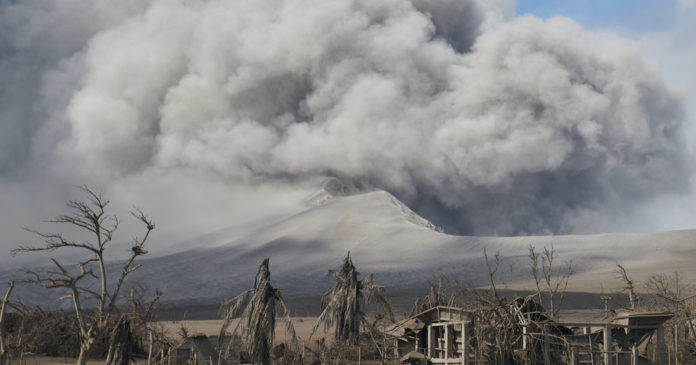TAAL VOLCANO, Philippines — The gray ash is knee-deep. It covers the homes, the bloated cadavers of cows and horses, their limbs protruding at unnatural angles in the shadow of a sulking volcano that could re-explode at any moment.
“My home is now gone,” said Melvin Mendoza, 39, a boatman who returned on Tuesday to Taal, the volcanic island in the middle of a freshwater lake just 40 miles south of Manila, which erupted on Sunday like an atomic bomb mushroom cloud.
The toxic ash and smoke, reeking of sulfur and other noxious gases, have transformed the verdant island, a popular tourist spot, into a vast carpet of lifeless gray. At least 30,000 people in a nine-mile radius of surrounding towns have fled, and the United Nations says as many as a half-million residents remain at risk. For now, the island is no longer habitable, and volcanologists say a fresh and perhaps more powerful eruption is possible.
Despite government warnings, Mr. Mendoza along with a few other residents of the volcano island ventured back from emergency shelters on Tuesday to see firsthand what remained of their homes and perhaps salvage a few belongings. A reporter and photographer from The New York Times accompanied them.
Among the first challenges they faced was the two-foot depth of the ash as they sloshed ashore from a motorized canoe. It was difficult to see precisely where the water ended and the land began. Hundreds of dead ash-coated tilapia bobbed in the gentle current, injecting the smell of rotting fish into the sulfur-scented air.
In some places rain already had hardened the ash, like crusty snow, making it relatively easy to walk over. Elsewhere the ash was still soft and treacherous.
Mr. Mendoza choked back tears as he salvaged a plank of wood from what had been his house.
“We had happy memories here,” he said. “The island sustained our livelihoods, but also took everything back. Everything’s gone in the blink of an eye.”
Coconut trees are now blackened stumps. The menacing mountain belched plumes of smoke and ash with ultrafine particles that are dangerous to breathe.
Just steps away from a horse’s cadaver stood the remains of Taal’s tourist office, a two-storey cement building that was once the busiest on the island, hosting more than 2,000 volcano visitors a year. All the other buildings nearby have collapsed.
One of the Philippines’ most active volcanoes, Taal roared to life with a jolt on Sunday, catapulting ash a mile high and triggering dozens of earthquakes that panicked people as far away as the Manila metropolitan area, home to nearly 13 million people.
The government’s Philippine Institute of Volcanology and Seismology said Tuesday that Taal remains on the fourth of a five-step alert level, meaning that another hazardous eruption remained possible within hours to days. It said that all residents on the volcano island should stay away, and warned of a heavy and prolonged ash fall.
A thick column of ash rising from the Taal crater could be seen for miles around, and fragments from the volcano could be hazards to aircraft, it said.
The volcano has erupted about 35 times in the last few hundred years, volcanologists said. The last eruption was in 1977.
There was little warning before the eruption on Sunday, which sent residents of the island scrambling for safety, leaving everything including farm animals behind.
Mr. Mendoza said he felt lucky. His wife, Jasmine, 34, and two young children, ages 14 and 10, escaped unscathed.
“As long as we’re alive, there’s hope,” he said.
Others who returned in small canoes on Tuesday found some of their livestock had survived. One farmer miraculously loaded a water buffalo aboard a canoe.
Another rummaged through a crack in the ash-covered earth and emerged with a plastic bag of stuffed toys. “These are owned by my nieces,” he said as he pointed to a mound. “Our house is under that.”
Amid reports that the government may permanently bar residents from going back to the island, the men risked arrest by the Coast Guard, which has deployed officers in towns surrounding the volcano to ensure a complete evacuation.
For Roger Holgado, a 56-year-old resident of the volcano island, not returning is not an option. Mr. Holgado said he had been born on the island and spent his whole life there. He witnessed the last eruption 42 years ago when he was just a teenager.
“I have seen the island being restless before but it has always calmed down,” he said. “I’m sure it will again this time, because I don’t know what we will do.”
Mr. Holgado said the family had operated a small lottery business on the island, which had provided for him, his wife and nine children.
Renato Solidum, the government’s chief volcanologist, said Tuesday that Taal has been emitting lava ever since its eruption, accompanied by significant earthquakes — all pointing to more trouble.
“The condition of Taal Volcano is dangerous and an explosive eruption is possible within hours,” he said.
Source : Nytimes













